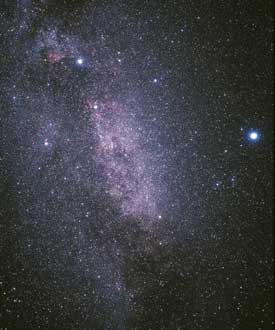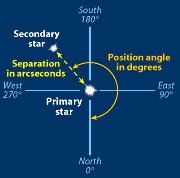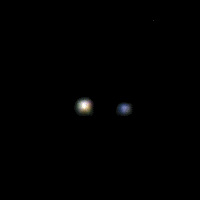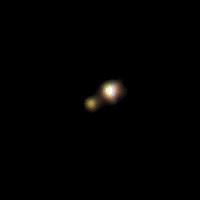
Cygnus is home to several attractive double stars, five of which appear on the list in this article. Albireo marks the foot of the Northern Cross and is one of the most colorful and best known pairs in the entire sky. The bright object on the right side of this photograph is the (single) star Vega.
Courtesy Akira Fujii
In "Pretty Double Stars for Everyone" I presented 42 double or multiple stars chosen for their beauty. When summer arrives in the Northern Hemisphere, another 54 gems become prominent. I hope you will agree with me that the two lists represent some of the most beautiful doubles and multiples visible.
The table on the last page has a couple of novel columns: color difference and optimum magnification. The color-difference rating refers to how far apart the two components are on the well-known OBAFGKM scale of spectral classification. For example, the blue and yellow stars of 24 Comae Berenices are class B and K respectively, yielding a color difference rating of 4. The final column suggests an optimum magnification.
Experience has shown me that doubles look best when viewed at a magnification determined by dividing 750 by the separation of the pair, given in arcseconds. For example, the components of the star Kappa (k) Herculis, also known as Marfik, are separated by 27.1 arcseconds; thus the optimum magnification is 750/27.1, or approximately 28x. The optimum magnification is typically about two and a half times the minimum required to resolve any given pair.
Some Fine Doubles

The two measures of a double star are separation and position angle. The directions shown here are for an inverting scope, such as a Newtonian reflector. Other telescopes may have different field orientations.
Sky & Telescope illustration
I often begin my observing evenings with the famous Double-Double, Epsilon (e) Lyrae. It's a handy check for seeing conditions and a stunning pair of pairs. Some observers think of Epsilon Lyrae as a tough test of telescope quality, but I've found that most scopes will split both pairs without much difficulty when the air is steady.
A tougher test of telescope resolving power is Porrima, Gamma (g) Virginis. The components are identical in both magnitude (3.5) and color, making them a perfectly matched pair. Porrima is easy to locate in the bowl of Virgo above Spica. This is a binary system with a period of 171 years. It reached its minimum separation of 0.4" in 2005.
If you find Porrima too challenging, try searching in Ophiuchus, about midway between Antares and the Teapot of Sagittarius. Here you'll find another perfectly matched pair in 36 Ophiuchi, whose magnitude 5.1 components are separated by 4.9".

Gamma Delphini
Courtesy Rainer Anton
Everyone's favorite colored double is Albireo, Beta (b) Cygni, and I certainly love it too. But have you tried viewing it in 15x binoculars? If mounted or stabilized, they'll certainly resolve it. Other colorful beauties that deserve attention are the triple Omicron (o) Cygni (also easy in binoculars), 24 Comae Berenices, and Epsilon (e) Boötis. If you have trouble resolving the latter, try a pale blue filter. This trick helps with other close colored pairs and on nights of marginal seeing — I've even used it to split Antares.
Two lesser-known but very pretty colored doubles with generous separation reside in Hercules: Alpha a Herculis (Rasalgethi) and 95 Herculis. Rasalgethi is easy to locate in southern Hercules, just 5° north-northwest of Alpha Ophiuchi.
Winding its way near the north celestial pole, the constellation Draco is blessed with the Northern Hemisphere's two best binocular doubles.

Gamma Leonis
Courtesy Rainer Anton
They feature separations ideal for 10x viewing. Nu (n) Draconis is a perfectly matched pair with components of magnitude 4.9. Nearby 17-16 Draconis is nearly its equal.
Three other doubles are so easy to find that they rarely escape my telescope on summer evenings. These are Algieba (g Leonis), Cor Caroli (a Canum Venaticorum), and Acrab (b Scorpii).
More Pretty Double Stars
| Star | R.A. | Dec | Mag. (primary) | Mag. (secondary) | Separation | Position angle | Color diff. | Magnification |
| 38 Lyn | 9h 18.8m | +36° 48' | 3.9 | 6.4 | 2.7" | 227° | 2 | 278x |
| g Leo (Algieba) | 10h 20.0m | +19° 50' | 2.3 | 3.5 | 4.5" | 122° | 0 | 167x |
| 54 Leo | 10h 55.6m | +24° 45' | 4.3 | 6.3 | 6.6" | 112° | 0 | 114x |
| x UMa | 11h 18.2m | +31° 32' | 4.3 | 4.8 | 1.7" | 273° | 0 | 441x |
| N Hya | 11h 32.3m | -29° 16' | 5.6 | 5.8 | 9.4" | 210° | 0 | 80x |
| 24 Com | 12h 35.1m | +18° 23' | 5 | 6.6 | 20.6" | 270° | 4 | 36x |
| g Vir (Porrima) | 12h 41.7m | -1° 27' | 3.5 | 3.5 | 1.7" | 265° | 0 | 441x |
| 35 Cam | 12h 49.2m | +83° 25' | 5.3 | 5.8 | 21.5" | 329° | 0 | 35x |
| a CVn (Cor Caroli) | 12h 56.0m | +38° 19' | 2.9 | 5.6 | 18.8" | 230° | 1 | 40x |
| z UMa (Mizar) | 13h 23.9m | +54° 56' | 2.3 | 3.9 | 14.4" | 153° | 0 | 52x |
| p Boo | 14h 40.7m | +16° 25' | 4.9 | 5.8 | 5.6" | 110° | 0 | 134x |
| e Boo | 14h 45.0m | +27° 04' | 2.5 | 4.9 | 2.6" | 341° | 3 | 288x |
| 39 Boo | 14h 49.7m | +48° 43' | 6.2 | 6.8 | 2.7" | 46° | 0 | 278x |
| a Lib | 14h 50.8m | -16° 01' | 2.8 | 5.2 | 230.7" | 314° | 1 | 3x |
| d Ser | 15h 34.8m | +10° 32' | 4.2 | 5.2 | 4.1" | 174° | 0 | 183x |
| z CrB | 15h 39.4m | +36° 38' | 5 | 6 | 6.1" | 305° | 0 | 123x |
| x Lup | 15h 56.9m | -33° 58' | 5.1 | 5.6 | 10.3" | 49° | 0 | 73x |
| b Sco (Acrab) | 16h 05.4m | -19° 48' | 2.6 | 4.9 | 13.6" | 20° | 0 | 55x |
| k Her (Marfik) | 16h 08.1m | +17° 03' | 5 | 6.2 | 27.1" | 12° | 0 | 28x |
| n Sco | 16h 12.0m | -19° 27' | 4.4 | 5.4 | 1.3" | 2° | 0 | 577x |
| 16h 12.0m | -19° 27' | 6.7 | 7.8 | 2.4" | 54° | 0 | 313x | |
| s CrB | 16h 14.7m | +33° 52' | 5.6 | 6.6 | 6.9" | 237° | 0 | 109x |
| r Oph | 16h 25.6m | -23° 27' | 5 | 5.7 | 2.9" | 339° | 0 | 259x |
| l Oph | 16h 30.9m | +1° 59' | 4.2 | 5.2 | 1.5" | 29° | 0 | 500x |
| 17-16 Dra | 16h 36.2m | +52° 55' | 5 | 5.5 | 88.9" | 193° | 0 | 8x |
| 17 Dra | 16h 36.2m | +52° 56' | 5.4 | 6.4 | 3.2" | 106° | 0 | 234x |
| m Dra | 17h 05.3m | +54° 28' | 5.7 | 5.7 | 2.2" | 20° | 0 | 341x |
| a Her (Rasalgethi) | 17h 14.6m | +14° 23' | 3.5 | 5.4 | 4.8" | 105° | 2 | 156x |
| 36 Oph | 17h 15.4m | -26° 36' | 5.1 | 5.1 | 4.7" | 148° | 0 | 160x |
| r Her | 17h 23.7m | +37° 09' | 4.5 | 5.5 | 4.2" | 317° | 0 | 179x |
| n Dra | 17h 32.2m | +55° 11' | 4.9 | 4.9 | 61.7" | 311° | 0 | 12x |
| y Dra | 17h 42.0m | +72° 09' | 4.6 | 5.8 | 30.1" | 16° | 0 | 25x |
| 41 Dra | 18h 00.3m | +80° 00' | 5.7 | 6 | 19.3" | 233° | 0 | 39x |
| 95 Her | 18h 01.5m | +21° 36' | 5 | 5.2 | 6.3" | 256° | 2 | 119x |
| t Oph | 18h 03.1m | -8° 11' | 5.2 | 5.9 | 1.7" | 282° | 0 | 441x |
| 70 Oph | 18h 05.5m | +2° 30' | 4.2 | 6 | 3.6" | 149° | 0 | 208x |
| 100 Her | 18h 07.9m | +26° 06' | 5.9 | 5.9 | 14.3" | 183° | 0 | 52x |
| e1 Lyr | 18h 44.4m | +39° 40' | 5 | 6.1 | 2.7" | 348° | 0 | 278x |
| e2 Lyr | 18h 44.4m | +39° 37' | 5.2 | 5.5 | 2.5" | 82° | 0 | 300x |
| z Lyr | 18h 44.8m | +37° 36' | 4.3 | 5.7 | 41.3" | 154° | 1 | 18x |
| STT 525 Lyr | 18h 54.9m | +33° 59' | 6 | 7.5 | 45.8" | 350° | 2 | 16x |
| q Ser | 18h 56.2m | +4° 12' | 4.6 | 5 | 22.6" | 103° | 0 | 33x |
| g CrA | 19h 06.4m | -37° 04' | 4.9 | 5.1 | 1.3" | 62° | 0 | 577x |
| b Cyg (Albireo) | 19h 30.8m | +27° 58' | 3.1 | 5.1 | 34.4" | 54° | 4 | 22x |
| 16 Cyg | 19h 41.8m | +50° 32' | 6 | 6.2 | 39.5" | 133° | 0 | 19x |
| 57 Aql | 19h 54.6m | -8° 14' | 5.7 | 6.5 | 35.6" | 170° | 0 | 21x |
| o Cyg | 20h 13.6m | +46° 44' | 3.8 | 7 | 105.8" | 174° | 4 | 7x |
| 20h 13.6m | +46° 44 | 3.8 | 4.8 | 338" | 323° | 4 | 2x | |
| b Cap | 20h 21.0m | -14° 47' | 3.1 | 6.1 | 205.2" | 267° | 1 | 4x |
| r Cap | 20h 28.9m | -17° 49' | 4.8 | 6.6 | 256.2" | 150° | 2 | 3x |
| g Del | 20h 46.7m | +16° 07' | 4.3 | 5.1 | 9.3" | 266° | 2 | 81x |
| 12 Aqr | 21h 04.1m | -5° 49' | 5.8 | 7.3 | 2.5" | 197° | 3 | 300x |
| 61 Cyg | 21h 06.9m | +38° 45' | 5.2 | 6 | 30.8" | 150° | 0 | 24x |
| m Cyg | 21h 44.1m | +28° 45' | 4.7 | 6.1 | 1.9" | 307° | 0 | 395x |
| z Aqr | 22h 28.8m | -0° 01' | 4.3 | 4.5 | 1.9" | 187° | 0 | 395x |
| d Cep | 22h 29.2m | +58° 25' | 3.5 | 6.3 | 40.9" | 191° | 3 | 18x |
 0
0
Comments
You must be logged in to post a comment.